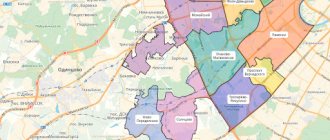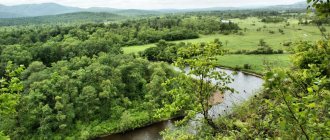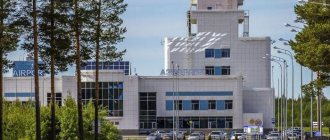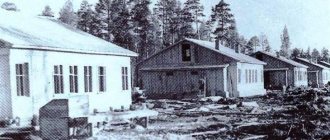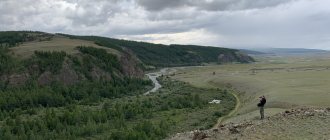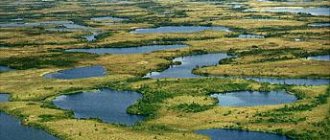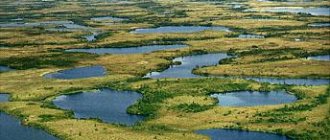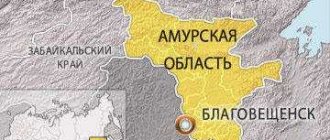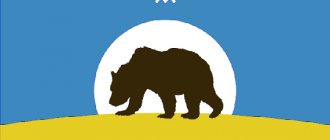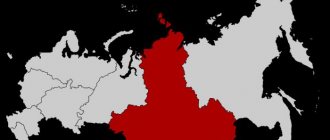Year founded: 1889
Anadyr celebrates City Day on
the 1st Saturday of August
.
In 2021,
this date is
August 7
.
In 2021, due to the pandemic, mass events in honor of the city day are canceled or may be postponed
Anadyr is the capital of Chukotka
Anadyr
– a port city in Russia, the administrative center of the Chukotka Autonomous Okrug. Located in the Far North, on the shores of the Bering Sea. The population of the city is more than 15 thousand people (2020).
The name of the city appears on the pages of historical chronicles in different versions: Onandyr - the Chukchi river, Anadyrsk - a fort from the time of Semyon Dezhnev (mid-17th century). In August 1889
the Novo-Mariinsk post was established at the mouth of the Kazachka River; the city of Anadyr began to develop from there. True, it became a city only in 1965. The local population still calls it Vien, which means “entrance,” or Kagyrgyn, “mouth,” which symbolizes its location in the upper part of the Anadyr estuary.
Most attractions
Anadyr is natural, but there are also a couple of interesting creations of human hands. Thus, in the city one can observe a toponymic paradox - a monument to the Orthodox Saint Nicholas the Wonderworker, located on the square named after the leader of the world proletariat Vladimir Lenin. The ten-meter-tall monument is lined with black labrodarite stone and looks harmonious next to the Cathedral of the Life-Giving Trinity. By the way, this is the largest wooden temple (its height is 25 meters) that has ever been built on permafrost, and, in addition, it is the only cathedral in the whole of Chukotka.
Cathedral of the Life-Giving Trinity (Photo: www.arcticphoto.ru) In the vicinity of Anadyr you can visit the Wrangel Island nature reserve, the Bereginya natural-ethnic park, several reserves, including Swan, Tundra and others.
On the territory of the district there is a unique crater lake Elgygytgyn of a perfectly round shape, formed about 3.6 million years ago. For most of the year its surface is covered with ice; sometimes it doesn’t have time to melt even in summer. The main holiday of Anadyr is City Day
. It is celebrated on the first weekend of August.
In addition, there are many other entertainments, each of which has its own place in the calendar. For example, in April the traditional dog sled race “Nadezhda” is held, almost 500 kilometers long. In the second half of April, residents of Anadyr say goodbye to the winter with the “Smelt Festival” - a smelt fishing competition. In the summer, since 1992, the Beriginya sailing and rowing regatta has been held, which has now become a festival of sea hunters.
Nature Reserve "Wrangel Island"
Exotic lovers, with a certain amount of luck, can appreciate the rituals of the tundra Chukchi. December 21–22 marks Pegytti, the Chukchi New Year; in January they celebrate the holiday of meeting the sun Tirkyk-emet; in February-March - Elgaatcon, dedicated to deer. The main holiday of reindeer herders, Vylgykaanmat, is celebrated from August to October: at this time, the autumn slaughter of reindeer is held with a thanksgiving ceremony.
In Chukotka and, in particular, in Anadyr, you can taste traditional dishes of the northern peoples - the Chukchi and Eskimos. The basis of their cuisine is venison, meat of sea animals, and fish. All this is usually eaten without a side dish, with bread. Currently, bay leaves, salt and black pepper are used in cooking. Stroganina made from meat and fish, yukola (dry unsalted fish), prerem (boiled and frozen venison), and kergipat (undercooked meat in its own juice) remain popular.
The best souvenir from Anadyr will be a product made by Chukotka craftsmen - bone carvers. Figures of northern animals and sculptural groups (hunting, reindeer and dog sleds) are carved from walrus tusk.
Chukotka Autonomous Okrug
Chukotka is located in the Far North. It completely occupies the peninsula of the same name, as well as several nearby islands. In Russia, this district is surrounded by the Magadan Region, Kamchatka Territory and Yakutia, and borders the United States in the east. Its shores are washed by the Pacific and Arctic Oceans.
Most of the district is located beyond the Arctic Circle. Only its inhabitants know what the sea is like in Chukotka: narwhals, fin whales, various whales and walruses. The temperature of local waters rarely exceeds 12 degrees. If we talk seriously about the seas of Chukotka, then these harsh lands are washed by three equally harsh seas - the Bering, Chukotka and East Siberian.
Winter here lasts almost ten months, and throughout the year there is a cold subarctic climate. The vast expanses with numerous hills, mirror-clear lakes and rocky shores are covered with snow most of the time. There is no summer as such in the region; the average temperature in July is only +5-+10 degrees. The region has almost no roads and no railways at all. The main transport on the peninsula is trucks and all-terrain vehicles.
The Chukotka Autonomous Okrug has many records. On the territory of the district there are the extreme eastern points of Russia (Cape Dezhnev and Ratmanov Island), as well as the northernmost (Pevek) and easternmost city of the country (Anadyr).
Within its borders is the easternmost permanent settlement - Uelen, and the northernmost port of the country - Pevek. The rocky Cape Navarin is the windiest place in Russia, and Wrangel Island is home to the largest population of polar bears in the Arctic.
Healthcare
In Ch. a. O. per 10 thousand inhabitants accounts for 71.3 doctors, persons avg. honey. personnel – 147, hospital beds – 149 (2013). The structure of the general morbidity of the population is dominated by respiratory diseases, cardiovascular diseases, injuries and poisoning (2013). The incidence of tuberculosis is 137.5 cases per 100 thousand inhabitants. (2013). Basic causes of death: cardiovascular diseases (40%), injuries and poisoning (21%), malignancies. neoplasms (10.9%), other diseases (12.6%).
Capital of Chukotka
Anadyr is the largest settlement in the district and its administrative center. It is located on the shore of the Bering Sea estuary of the same name, where the Anadyr and Kazachka rivers flow into it. A little to the west of the city is Onemen Bay. Anadyr is located on a slight rise, its center is at an altitude of 35 meters above sea level. To the southwest of it stretch vast areas of flat tundra, occasionally covered with hills.
This is one of the most remote cities in the country. Local time differs from Moscow time by as much as nine hours. Geographically, the city is much closer to Alaska than to the capital of Russia (700 km to Nome, 6192 km to Moscow).
The area of Anadyr is only 20 square kilometers. It is built up with panel and block high-rise buildings. The appearance of the city is a little unusual. All his houses are colorful and resemble a toy town. This is how they cope with the pallor of local landscapes, because a small number of sunny days and the lack of bright colors around can cause a bad mood and even depression.
Climate
The climate of Anadyr is subarctic marine. In addition, it has a monsoonal nature. In fact, there are only two seasons here, and with each change, the air masses also change. In winter they are cold and dry, coming from the continent. Their effect is softened by the proximity of the sea. Therefore, winters in the city of Anadyr are easier to endure than in other regions of Chukotka.
Summers are very short and much cooler than in the rest of the region. At this time, the city's climate is influenced by air currents from the ocean. They bring precipitation, fog and cloudiness, depriving residents of sunlight.
Winter in Anadyr lasts seven months, about 70 days of which there are snowstorms. Spring is almost invisible and lasts only for the month of May. Autumn lasts from late August to late September.
The average temperature in July is +11 degrees, in January it reaches -22 degrees. Very often strong winds blow, which can reach up to 45 m/s. In summer they lead to storms and hurricanes, in winter they create strong blizzards and snowstorms. In 1968, one of these winds carried a helicopter across the airfield.
Transport accessibility
Thus, we became acquainted with data on the demographic situation in this area. Now it’s worth talking about transport in Anadyr and in the region as a whole. Of course, this is an important component of any settlement. The transport structure here is represented by several components. Among them there is a seaport, aviation, roads and public transport.
First, of course, we need to talk about the port of Anadyr. This is an object that has truly important transport significance. From here ships depart to Vladivostok, Petropavlovsk-Kamchatsky, Magadan and other ports. However, the navigation period here does not last long, it is 4 months. Thus, transportation is carried out from July 1 to November 1.
As for the roads in the city, they are mostly concrete. There is a federal highway A384. It goes from Anadyr to the airport. The length of the road is about 23 kilometers. The city has several bus routes that connect the main important places.
As has already become clear, there is an airport here. Anadyr sends and receives planes from various cities. It is worth talking about this in more detail.
Animal and plant life
The nature of Chukotka is not as lush and colorful as in the tropical regions of the Earth, but it cannot be called completely poor either. More than a thousand species of mosses and lichens, as well as hundreds of species of trees and shrubs grow here.
The district is divided into an arctic desert zone, forest-tundra, tundra and deciduous taiga. The city of Anadyr is located in the tundra zone. Alder, cotton grass, sedge, dwarf cedar, rowan, blueberry bushes, lingonberries, rose hips, and shiksha grow around it. In addition, the tundra is rich in mushrooms. A large layer of permafrost prevents plants from deepening their roots. As a result, Chukotka's trees are not tall, and many look like shrubs.
The area is home to hares, bighorn sheep, black squirrels, chipmunks, minks, and predatory mammals such as fox, wolf, wolverine, polar bear, and sable. More than two hundred species of birds fly to the region. The waters of the Bering Sea are full of fish and marine mammals. In the Anadyr Estuary, locals catch smelt, pike, nelma, and salmon, and tourists watch seals and beluga whales.
History of the district capital
The history of Anadyr as a city is connected with the development of the northern lands by Russians. Chukotka was discovered thanks to Semyon Dezhnev in 1648. Then the region was nicknamed Zakolymye. In 1660, on the site of the first winter hut, the Anadyr fort was founded, which was located 10 kilometers from the village of Markovo.
In 1889, researcher and doctor Leonid Grinevetsky founded the Novo-Mariinsk post in the Anadyr Okrug, placing it on the shore of the estuary. At that time, Chukchi settlements were located on these lands. The location was very convenient - the spit consisted of rubble, not swampy tundra, and was a small hill.
Gradually, the post began to grow into a village, which later became the capital of Chukotka. It was renamed Anadyr in 1924. At this time, about 200 people lived here, there was a library and a first-aid post. Ten years later, the industrial development of Chukotka began, and Anadyr became the center of the district. Its population increased to a thousand people.
The first school and pedagogical college appeared in the village. During wartime, reserve airfields were built here, and the production of edible tin began. After World War II, the settlement continued to expand: a seaport was created, a dam was built on the Kazachka River, and the first water supply system appeared. In 1965, Anadyr received city status.
Historical sketch
“Winged object” (harpoon stabilizer). Bone. 1st millennium. State Museum of Oriental Art
People first appeared in the region in the Late Paleolithic, exploring lands freed from glaciers. The earliest archaeological the monuments date back to the 7th–4th millennium BC. e.; stone tools have analogues in Siberia and Mongolia, as well as in Alaska, where resettlement took place along the land “bridge” (Beringia). Since mid. 2nd millennium BC e., along with the cultures of tundra hunters, mora cultures emerged. hunters, close to the ancient Eskimo cultures of the North. America: Paleo-Eskimo island. Wrangel, ancient Bering Sea culture, Birnirk, Punuk. On their basis, ethnic groups developed. communities of Asian Eskimos and Kereks. All R. 2nd millennium AD e. in the continental regions of Chukotka among the tribes that made up the Chukchi-Koryak ethnic group. community, nomadic reindeer herding arose, which contributed to the further development of the region and the formation of new ethnic groups - the Koryaks and Chukchis. Fragmentation of the Chukotka-Koryak community into departments. ethnic groups were accelerated by contacts of hunters and reindeer herders of the Chukotka tundra with the Yukaghirs. According to one of the hypotheses (“Yukaghir wedge”), the Yukagirs, moving to Chukotka from Kolyma, divided its continental inhabitants into southern (Koryaks) and northern (Chukchi) groups. According to another point of view, the Yukaghirs have long lived in the center. areas of the region, and the separation of the Koryaks and Chukchi occurred as a result of the “infiltration” of reindeer herders moving north through the Yukaghir nomads. tribes Household and ethnic. the diversity of the inhabitants of Chukotka often led to war. clashes, but gradually close relations and strong economies began to be established between them. communications.
Appearance on the territory of modern Ch. a. O. Russian dates back to the 1640s. In 1647, a party of fishermen headed by I. I. Mezents arrived in Chaunskaya Bay. In 1648–49, the expedition of S. I. Dezhnev and F. A. Popov sailed around the Chukotka Peninsula. In 1649 Dezhnev founded in the middle reaches of the river. Anadyr winter quarters, on the site of which the Anadyr fort was built in 1652. The relationship between Russians and the indigenous population was complex throughout the 17th and 18th centuries. The Chukchi repeatedly committed military attacks on Russian detachments and peoples who paid yasak. In the end 17th century The Anadyr fort acquired a strategic meaning as a starting point plural. expeditions. After the discovery of the Kamchatka Peninsula, more and more new forts and winter quarters were subordinated to the Anadyr fort, but after the main. on the way to Kamchatka in the 1st half. 18th century became maritime, it ceased to be the center of the Chukotka-Kamchatka Territory (demolished in 1771). The actions of the expedition of A.F. Shestakov - D.I. Pavlutsky in 1729–31 led to the formation of a permanent military. Anadyr Party and the strengthening of Russian. presence in Chukotka. 11(22).10.1779 imp. Catherine II officially announced the acceptance of the “Chukotsky people” as citizenship.
The region was part of the Irkutsk province (before 1803, in 1812–49; in 1783–96 Irkutsk governorship), Kamchatka region (1803–12, 1849–56, 1909–22), Primorsky region (1856–1909), western. part - into the Yakut region (1805–1920) and the Yakut province (1920–22).
After Russia sold Alaska to the United States under the Washington Treaty of 1867, Americans rushed to the coast of the Chukotka Peninsula. trading companies, later Japanese. the Nihon Mohi company, British, Norwegian and other fishermen and traders. Predatory hunting of sea animals and whales began to develop intensively. Furs, whalebone, walrus tusk, deer and dogs were exported from Chukotka. In an effort to strengthen the growth. presence in the region, the highest approved by the 9(21).6.1888 opinion of the State. The council formed the Anadyr district (since 1902 a district) initially with the center in the village. Markovo. In 1889 as the new adm. The center was founded at the border post of Novomariinsk (since 1923 Anadyr). 17(30).6.1909 as part of the newly formed Kamchatka region. created, along with Anadyr, Chukotka district. (center - Providence Bay, since 1912 - Uelen village). In the 1920s b. part of the region was part of the Kamchatka province (1922–26), Kamchatka env. Far Eastern Territory (1926–30), west. part - to Yakut. ASSR (1922–30).
By decree of the All-Russian Central Executive Committee of December 10, 1930, Chukot was formed. national district with time center in the Chukotka cultural base - St. Lawrence Bay. Initially included 6 districts: Anadyrsky, Vost. tundra, Western tundra, Markovsky, Chaunsky and Chukotsky. Was part of the Far Eastern Territory (1930–34), Kamchatka region. as part of the Far Eastern (1934–1938) and Khabarovsk (1938–51) territories. By the Decree of the All-Russian Central Executive Committee dated May 10, 1931, the Western District. tundra transferred to Yakut. ASSR. In 1932, the center of the district was moved to the workers' village. (since 1965 city) Anadyr. In fact, from 1939–40 the territory of the district was under the control of Dalstroy. From the end 1930s mining of brown and hard coal began in the 1940s. in the main With the help of prisoners of Chukotstroylag (1949–1956; since 1952 Chukotka forced labor camp), the construction of tin mines began, as well as the Severny uranium mine (mining until 1953).
By decree of the Presidium of the USSR Armed Forces dated May 28, 1951, the district was transferred directly. subordination to the Khabarovsk Territory, by decree of the Presidium of the USSR Armed Forces dated December 3, 1953 - to the Magadan region. In the end 1950s Rich deposits of placer gold were discovered. Pevek received city status in 1967. According to the Constitution of the USSR of 1977 (confirmed by the Constitution of the RSFSR of 1978 and the Law of the RSFSR of November 20, 1980 “On Autonomous Okrugs”) it was renamed to Ch. O. By the Law of the Russian Federation of June 17, 1992, it was removed from the Magadan Region and became independent. a subject of the Russian Federation, which is enshrined in the 1993 Constitution of the Russian Federation. Since 2000, it has been part of the Far Eastern Federal District. Economic rise and social development of Ch. a. O. fell during the governorship of billionaire R. A. Abramovich (2001–08), who headed the district on the initiative of Russian President V. V. Putin.
Population
Residents of the city are called Anadyrs. In terms of population, Anadyr is the largest city in Chukotka. It is home to about 15,000 people. These are mainly Russians, there are also Ukrainians, Belarusians and Tatars.
The indigenous population of Anadyr and the entire region are the Chukchi, Evens, Eskimos and Chuvans. They are engaged in traditional crafts: fishing, raising deer, hunting whales. The emergence of industrial cities and towns also influenced their life. Those who live in cities often work in local businesses and live in standard apartments, like non-Indigenous residents.
But the majority adhere to the traditional way of life and even make money from tourists. They move further away from cities, periodically wandering across the expanses of the tundra.
The most numerous ethnic group is the Chukchi. In Anadyr in 2002 there were 1,200 people. Near the city is their ethnic village Tavaivaam. There are much fewer representatives of other nationalities. In 2002, there were 153 Eskimos in the city of Anadyr, 200 Chuvans, and 142 Evens.
Many Chukchi still live in communities. They fish and sell handicrafts as souvenirs. Their traditional home is called yaranga. This is a portable tent covered with animal skins. You cannot see them in Anadyr or Tavaivaam, since ordinary panel houses were built there for the Chukchi.
The religion of the people, like that of the Eskimos, is animism. The Chukchi believe in the spirituality of the forces of nature, luminaries and animals, and believe in the existence of evil spirits. On some holidays, it is customary for them to “feed” the constellation or make a sacrifice to fire.
Life in Anadyr
This city is very clean and well maintained. All buildings and residential buildings in it are built on stilts, and communications are carried out on top. This is done due to permafrost. It comes very close to the surface of the earth. In contact with buildings, its upper layers can thaw and damage the strength of the foundation.
Such a remote geographical location also affects local prices. Living in Anadyr is very expensive. The cost of food and gasoline is almost twice the price in Moscow. There are few local products in the region, mainly deer meat and fish. The rest of the products are delivered to the city.
Residents of the city work at the fish factory, as well as at coal and gold mining enterprises, which are located nearby. There are two power plants in Anadyr - thermal and wind. The Anadyr wind farm is considered one of the largest in Russia.
You can get to the city by air. The local airport has flights to Khabarovsk and Moscow. It is located on the other side of the estuary, from which a helicopter flies to Anadyr.
Economy of the city
Of course, you need to talk a little about what kind of enterprises exist in this locality. A large fish production plant operates on the territory of Anadyr. In addition, gold and coal deposits are being developed near the city. There is also a thermal power plant here.
However, this is not all that Anadyr can boast of. Russia has several wind power plants, but the largest of them is the Anadyr Wind Farm. It provides electricity to several nearby villages, as well as the airport.
Sights of Anadyr
The capital of Chukotka is not short of attractions. On the main square of the city - Lenin Square - there is a museum "Heritage of Chukotka". This is a very modern center with multimedia screens and other innovations. In it you can get a closer look at the life of Chukotka and the history of its development.
The Holy Trinity Cathedral on the shore of the estuary is the world's largest wooden church, which stands on permafrost. It was founded only in 2002. The temple was built taking into account all the nuances of local soils and weather. Thus, refrigeration units in its foundation do not allow the soil to heat up higher than -3 degrees, and all the aisles are combined so that the building can withstand cold and wind.
In Anadyr there is a monument to Nicholas the Wonderworker, writer Yuri Rytkheu, a monument to Lenin and several memorials. Mount St. Dionysius is located 50 km from the city; other mountains are visible across the river to the west. About 7 km away there is St. Michael's Hill, on which there is a tropospheric communication station.
City sports spots
Sports tourism is well developed in Anadyr. There are sports and recreation centers and open areas for active recreation, where tourists will find entertainment to their liking.
Ice rink
- Address: Chukotskaya, 15.
In the city of ice and snow, corresponding sports are popular. The ice arena is the best sports complex in the city. Hockey teams and figure skaters train and compete here. During free time, the skating rink is open to the public.
The complex has a section for teaching skating for children. Instructors teach children how to skate, avoid obstacles and maintain balance.
The complex offers rental of sports equipment. Beginners can use the holder. The skating rink is in excellent condition. The ice is polished after each skating session, and cheerful music creates a pleasant atmosphere and puts visitors in a creative mood.
City Stadium
- Address: st. Otke, 25.
The stadium is located near the embankment. It includes a mini-football field and a basketball court with an ice skating rink in winter. The stadium is kept in perfect order, the surface is replaced every few years. Tourists who visited the site note its comfort. Most of all, children and teenagers like to spend time here.
A fitness center
- Address: st. Energetikov, 7A.
The fitness center occupies a modern building in the constructivist style. The complex has the best gym in the city. Visitors can take advantage of a local instructor and book a personal training session. The infrastructure also includes showers, changing rooms, a buffet, a massage room and a relaxation room.
Souvenirs
The main, and most importantly, tasty purchase in the capital of Chukotka can be red caviar and fish. They are easy to find in the store, but it is better to get them from local fishermen. The Chukchi sell a kilogram of caviar for about 400 rubles.
Special permission is required for your own fishing and the purchase of some souvenirs. But you can pick berries and mushrooms freely. They begin to appear in the summer-autumn period. On the pebble beach of Anadyr, in addition to the usual crushed stone, you can find onyx and other gems. They will be an excellent souvenir.
A permit will be required for those who want to take seal tusks or deer antlers with them. A ball made from seal skin can also serve as an exotic item. Traditional souvenirs also include items made from whalebone, carved figurines made from bone or fangs, and clothing made from leather and animal fur.
Mass media
News agency – “Chukotka”.
The largest periodical in the district is the newspaper “Far North” (Anadyr; since 1933; weekly, about 4 thousand copies, supplement in the Chukchi language).
Radio broadcasting since 1935, television since 1967. Broadcasting of television and radio programs is carried out by the Chukotka State Television and Radio Broadcasting Company.
There are few regional Internet media - regional branches of federal online publications and aggregators (TASS, Rambler, RIA, etc.) predominate; among the regional ones there is the portal “Chukotka - a beautiful and ... harsh land.”
